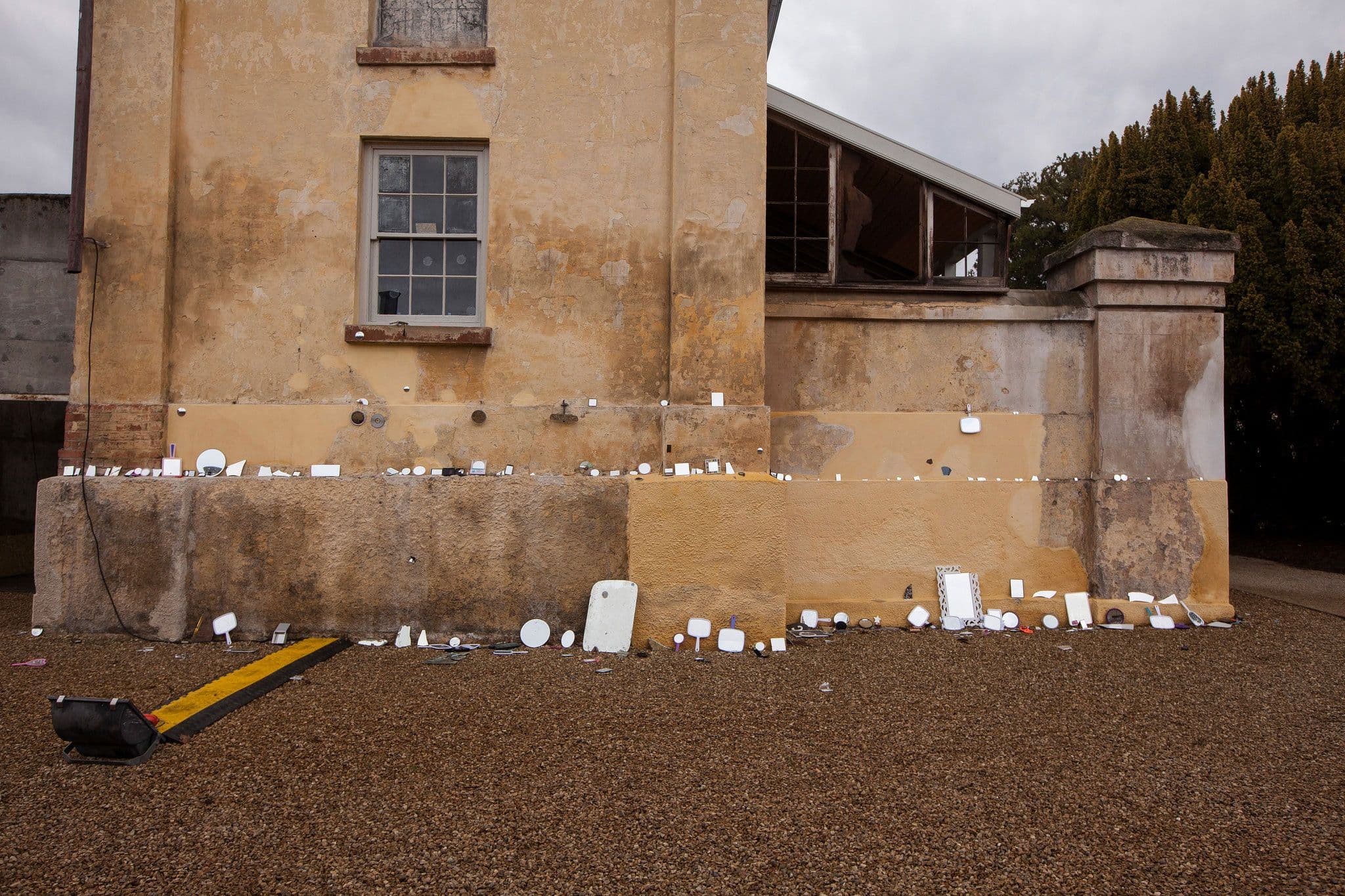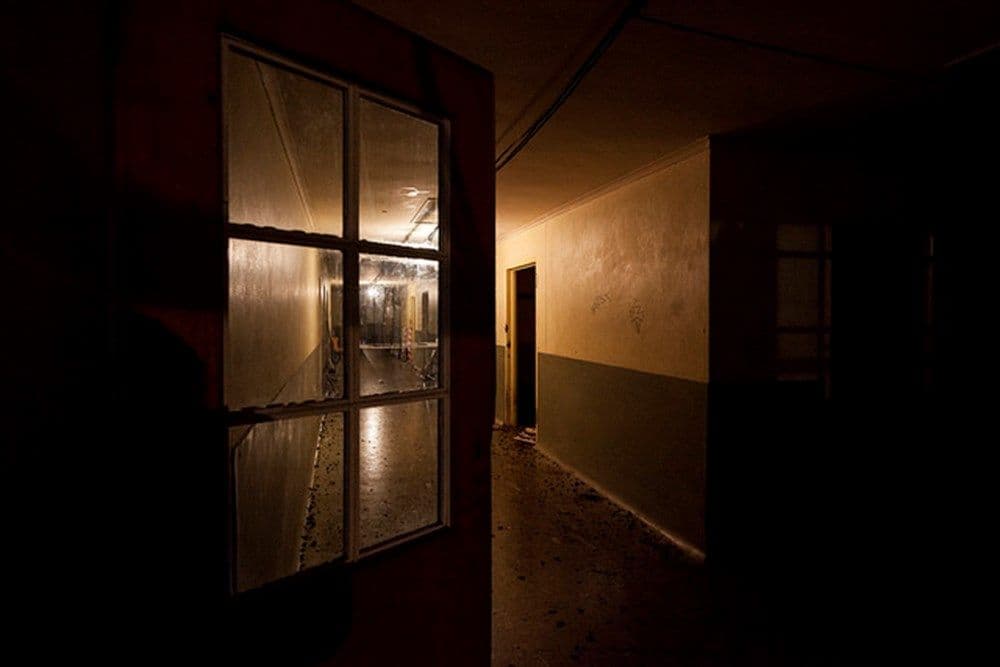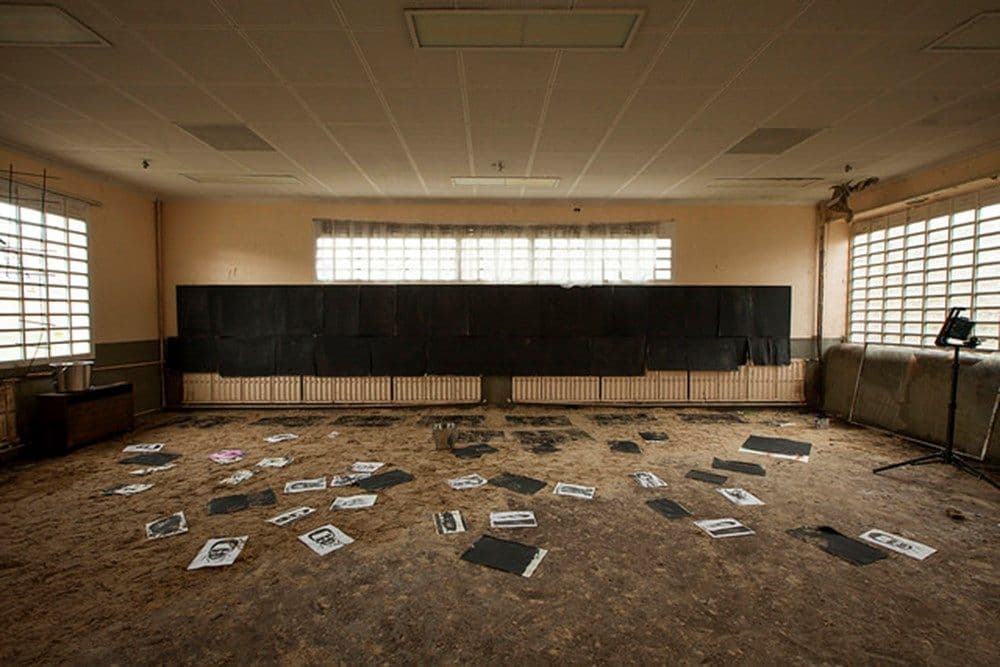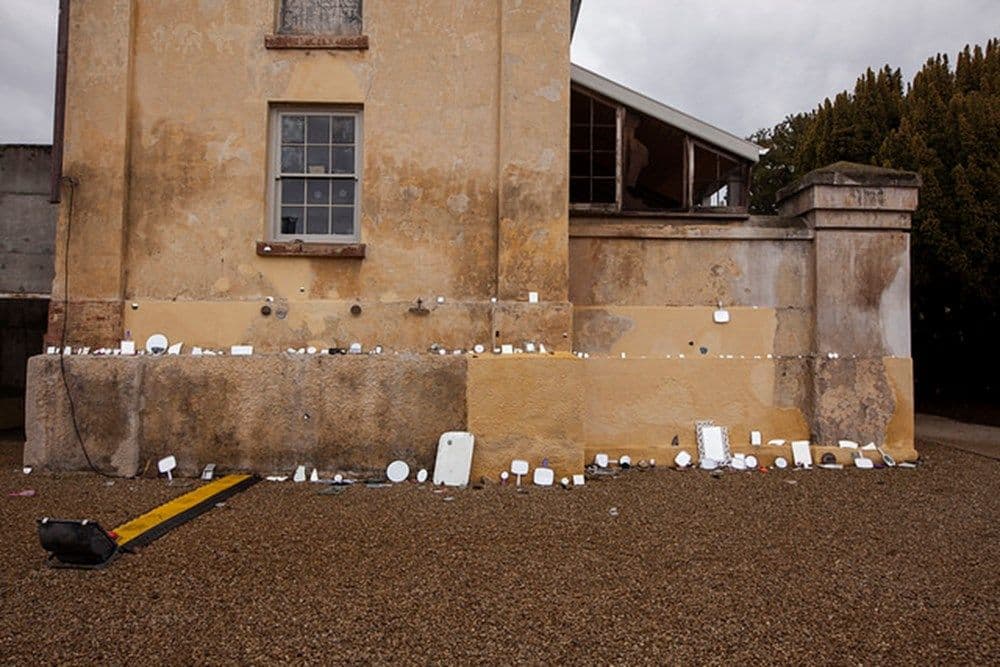An interview with Mike Parr

Mike Parr’s Asylum [Entry by mirror only] was an exhibition and performance that took place during our most recent Dark Mofo festival. Parr took up residence at Willow Court, New Norfolk – a clutch of buildings that once housed Australia’s oldest asylum for the criminally insane. There, he drew continually for 72 hours, in memory of his brother, Tim, who died in 2009 after suffering from mental illness for much of his life. Video, sound, photos, objects, and installation works were dotted throughout the buildings. Visitors were welcome to come and go, on the condition that they brought a mirror to deposit somewhere on the site.
Elizabeth Pearce:
How did you prepare for the performance?
Mike Parr:
I fasted for about a week. That means you don't have to interrupt the performance going to the bathroom and things like that. But also, fasting really concentrates your mind, because you're interrupting the indulgence of your normal pattern of life. It throws you back on yourself and you've got to firm up your mind. I also meditated a lot, which complements the fasting and gives you focus and resolution, and helps you anticipate your own anxiety. I think it also entails an ethical dimension. For me it seemed the appropriate way to be in Willow Court.
EP: What mental and emotional state were you in while you were performing?
MP: I was feeling very anxious a lot of time, but I was drawing constantly. Sometimes I could concentrate and draw quite deliberately and other times I started to spill all over the place. I found that place really claustrophobic to be honest.
EP: I don't blame you!
MP: And the smell. And the realisation that I was occupying a cell that some people would have occupied for years. Some of those people were incarcerated for most of their life. I was continually aware of that.
EP: Were you thinking about your brother?
MP: I did think a lot about Tim. When I tried to sleep, late at night, I found myself thinking about him. I was with him when he died. He was in a sort of coma but he was very calm. I felt he was just floating and going with the whole experience. I thought about that, and it took away some of the threat of that place. It allowed it to become just a series of buildings. I began to realise that the nursing staff and the doctors would have been doing their best. They were trying to manage a very difficult situation.
EP: Willow Court has a contested history. It strikes me as like a microcosm – an emotionally explosive microcosm – of Tasmanian history more broadly. People have very mixed feelings about it. There's a lot of pain and anguish and suffering, but at the same time they're always asserting the fact that it's their history, and they're owning it and proud of it at the same time. In Willow Court, as you well know, there are accounts of the abuse and suffering of the patients, but also stories of the kindness, care and respect the staff showed towards them as well. Did you want to get involved with that contested history in any way, or let it lie, and just have it there as a backdrop?
MP: I did want to get involved with it. And two very strange things happened. On the Friday night of the performance – and Felizita, my wife of many, many years, she didn't tell me this at the time – but our next door neighbour, a young man, committed suicide. Then on the Saturday morning, a young man came up to her – he was my father's sister's grandson. Our Uncle Oliver was a neurologist who worked at Callan Park [Hospital for the Insane in Lilyfield, Sydney] and Morisset [Asylum for the Insane on Lake Macquarie] and also would have been in attendance at Willow Court. He had family who lived just outside of New Norfolk. I never knew this. So what I'm driving at is that I felt as though the history of Willow Court didn't exclude me either. I mean, obviously this terrible business of our young neighbour committing suicide isn't directly related to Willow Court – but it is related at the level of mental illness, and my brother’s death. What I'm saying is that Willow Court has become magnified for me, in the same way that perhaps the performance magnified memories and experiences for a lot of Tasmanians at the same time. The performance is very significant to me in that way. I haven't just filed it away as just another performance.
EP: The idea of asking the audience to bring a mirror seemed to me like a gesture of communal implication.
MP: Yes, I think that's right. You've blatantly got your own image there. To even furtively see yourself is to realise that you're implicated – but not trapped, because everyone was free to deposit that mirror in any way that they felt to be significant. Some people came with a huge mirror with lighting, and some came with all kinds of fragments and little mirrors, and inserted them back into those buildings in the most extraordinary way. So I really felt that this was the bridge to the community. It allowed them in – in a kind of protected way, because they chose their mirror and what to do with it.
EP: Do you think the reaction from the New Norfolk community and from Tasmanians more broadly has been positive?
MP: I think it has been. On the Monday after the performance we returned to the site. I didn’t want to go into the installation spaces but I went to that little cafe on site – it’s very low-key – and I lined up for a coffee. The waitress came up to me and said 'Mike Parr' and I realised that I'd been sprung. Then a number of people came up to me. One man said that his grandfather had spent most of his life at Willow Court. He sort of thanked me, because – and this was repeated by people in New Norfolk and beyond – he said the performance had enabled him to go back to Willow Court. I think what they were saying was that it enabled them to confront something that they hadn't previously wanted to confront. This was the individual response, but I think it created a kind of solidarity too. After my coffee I walked through New Norfolk, towards the church. In the garden of the church there was this elderly couple – they were really warm, and acknowledged me over the fence. I noticed different sorts of reactions like that as I walked through New Norfolk. Then I ran into [Derwent Valley Mayor] Martyn Evans. I really like Martyn, he's a sincere guy I think. We spent an hour together. He really wanted to talk to me. He wanted to talk about himself. He wanted to talk about a tragedy in his own life, and then he wanted to talk about the importance of Willow Court and his determination to try to build on the performance, to consolidate it as some sort of memorial site. I said to him that the black-painted drawings and all of those mirrors should be consolidated as an installation. He was very enthusiastic about that idea. So, my final feeling was that it had been a performance that had brought people together and that allowed people to think through stuff that they hadn't really wanted to think about.
EP: What about you? This performance was an opportunity to think about and remember your brother. Were you looking for atonement for yourself?
MP: Yes, I was in a way, because I seem to have felt in the end… I suppose this is the inevitable guilt of any situation like this. Tim went into a final decline, and it was driving me mad. I had been looking after him for years, and it was obvious that his final decline was tied up with going back into alcoholism again, pill popping, and all the other stuff that goes with a collapse. I couldn't get him out of it. I can remember the last coherent thing he said to me was, ‘I don't want you to help me anymore. It's my life.’ That was the last coherent thing he said to me.
EP: I'm so sorry for your loss.
MP: I think this performance helped enormously.
EP: What about the exhibition component – the works you installed throughout the buildings to accompany the performance. Were you trying to create a particular narrative?
MP: I had this realisation when I first visited the site that the whole place was so monumental and disturbing that it really wasn't a place for an artist to do an ‘exhibition’ as such. I felt that it wasn't about that kind of self-assertion or ego. I was interested in the state of the rooms, as they were. I was also very interested in the kind of order that had been brought to some of the rooms. In the barracks, the order was the result of people there trying to sort of excavate and tabulate. So it was a kind of academic order, in which people try to impose a taxonomy on the detritus. It was the sort of imposition that you often see in installations by artists. So I felt that all I needed to do in many instances was just interpolate a work by myself, one that somehow magnified or twisted your immediate perception of the room or the space. I felt as though I was working at the edge of the history and the disturbance of that architecture. I was magnifying what was there and drawing people’s attention to it, but at the same time the obverse of this was the idea of people depositing their mirrors. It occurred to me that maybe it should be just that – just the space, and the mirrors. But then I thought that people might be experiencing anxiety, remembering family members and so forth, and that there needed to be a reciprocity there – I needed to make my own contribution to those spaces too, otherwise it might be too overwhelming. I felt I needed to expose my own anxieties as an artist, to create a kind of solidarity. But I did want to keep the whole thing very episodic and inconclusive.
EP: It would be easy to emphasise the political aspect – just the word ‘asylum’ has a loaded meaning in this country, and obviously some of your own works that you chose to exhibit at Willow Court revolve around your response to Australia's foreign policies and treatment of asylum seekers. Is that something that you really wanted to draw out?
MP: I was aware that using the word ‘asylum’ would resonate in that context. This is a culture that perennially reverts to the same pattern of anxiety – the yellow peril, the White Australia Policy. It's got to do with the size of the place, the smallness of the population, our persistent call for identification with Britain and Europe, and our European origin – even though that origin is increasingly less significant. But it still produces the same sort of collapse. So I did realise that. Willow Court goes so far back. They've been locking up people there for a very long while, with ‘madness’ as a catch-all category. It would have included convicts, and remnants of the Aboriginal population I imagine.
EP: Promiscuous women?
MP: Probably, yep. Any deviation from the norm. These days we disperse [people who deviate from the norm] and they arrive at the end of their life sleeping rough in bus shelters or vacant lots. Or else they're on Manus Island or Nauru. We’re too sophisticated to bring everyone together in one complex. If you keep them moving as it were, if you disperse the problem, it actually becomes much more manageable at the level of government policy. You can't make the linkages between the zones of oppression, and you can treat each problem in an unrelated way, as specifics – when really they should be thought about collectively, because they speak to a kind of zeitgeist, an anxiety, and a kind of eternal return.
EP: When I spoke to you a few years ago you told me that in your early performance pieces, you were keen not to define your role in relation to the audience in any particular way. The way to do that was to not show any distress. I'm thinking in particular of the performance where you asked your friend Peter Kennedy to bite your arm repeatedly. You wanted to avoid any kind of emotional reaction because then it would define you as a patient or a victim, and the audience as your rescuers or saviours.
MP: Yes, exactly.
EP: What kind of relationship did you want to create between yourself and the audience at Willow Court?
MP: I wanted the same sort of separation. In the final stages of that performance I left the cell to take drawings to put in what I called the ‘drawing room’ and the people all followed me. But I became aware of the fact that they were also recoiling from me. I suppose I was starting to look a bit like a patient. I was dishevelled. I imagine I was becoming very dirty because of the drawing process just for a start, and I was becoming sort of wilder. I'd been in my own head by that point for quite a long while, in the lead-up to the performance and during it. So I must have seemed odd. But I felt that however they perceived me, it was important not to allow the space between us to be breached.
I've got these rules for performance that are very fundamental and that distinguish performance from theatre. Theatre is trying to construct a mimesis and catharsis – that Aristotelian notion. Within traditional theatre that's a well-managed procedure and people might pull out their lace hankies and pat their eyes, but it's not the kind of realism that I am interested in. Performance art for me is extreme realism. I think I'm a realist, essentially, as an artist. It's really important to maintain this separation, because it builds a tension and imposes a complicity, where I'm not just a performer. I'm a kind of ‘other’. I'm the person that is not just a performer in a lunatic asylum – I come to be the person that was detained in that asylum. If you sustain this separation, this radical gap between the idea of performance and the audience, and you tension the gap to a real degree, they're no longer an audience and you're no longer a performer.
EP: Do you think that you struck that right balance?
MP: Yeah. I could feel people recoiling from me. I think we were in the zone of the real. It goes way beyond theatre. It's a kind of moral barrier, because to collapse that barrier is to be back into a situation where everyone plays a familiar role. You've got the people that go into sort of nurse mode, and worry conspicuously, then you've got the artist who's the victim and the agent of the failed provocation. Then you're back into sort of something that is the worst sort of art – therapy. Therapy for the performer and therapy for the audience.
EP: Therapy is the antithesis of what you’re trying to do?
MP: That's right. I get terribly upset talking about Tim but I don't want any therapy. I don't want to be put back into that situation where you've got this ‘expert’ intervention. The expert intervention in our culture is a big part of the problem, like when it comes to refugees. The government's project is basically to manage this problem into a kind of oblivion, make it unreachable by normal human responses. It’s exactly this situation that the structure of performance art should confront.
EP: Ultimately it's a challenging of roles on all levels.
MP: Yes. It's the fact that we're always invited as a solution to a problem. We're always given a role in relation to that problem. [Refusing this] has determined my position as an artist.
EP: You're trying to reach a point that's prior to roles?
MP: Yes. Performance art always puts you in a kind of limit state. You're deposited at the edge of the present tense with the ‘audience’ – in inverted commas, because they're not the audience, by virtue of also being deposited at the edge of the present tense. It’s a formative situation without any real precedence.
EP: Your drawings that you did at Willow Court, were they all self-portraits?
MP: They were, but they all entailed a kind of reaction to the image. At one point I got into a rhythm and I produced some really interesting drawings. But I didn't want to retain any of them, certainly not just because they were interesting. The self-portrait for me is sort of like a zone, a performative zone. It starts as an image but it produces a reaction, and I'm prepared to be completely uncompromising or totalising about that reaction. I was reacting to those drawings while I was producing them. It was inevitable that I would paint them out I suppose. I thought of it on Saturday night and I said to Felizita, ‘I want you to get me a can of black paint and a brush,’ and she said, ‘You don't have to do that.’ She knew immediately what I was thinking. But by Sunday morning I was determined to do it. I thought ‘I've got to get rid of these. This is no place for self-expression. I've got to block them completely.’
EP: Is that the ethical dimension you spoke about earlier?
MP: Yes. I thought, ‘No one here had an opportunity for self-expression.’ That's why they were in there. They were self-expression. Like how you said – the promiscuous women. What was being blocked was the possibility of difference, and self-expression is the assertion of difference. I thought, ‘No, I'm not going to assert difference in this place. I'm going to just black them all out. Bugger it.’ So I felt that the real tension with the blacked out drawings was the mirrors that everyone had deposited because they'd all blatantly deposited their own self-portraits. It was the fragments of mirror that reflected everyone else and everything else.

Asylum [Entry by mirror only]
Mike Parr
Photo Credit: Mona/Rémi Chauvin

Asylum [Entry by mirror only]
Mike Parr
Photo Credit: Mona/Rémi Chauvin

Asylum [Entry by mirror only]
Mike Parr
Photo Credit: Mona/Rémi Chauvin

Asylum [Entry by mirror only]
Mike Parr
Photo Credit: Mona/Rémi Chauvin